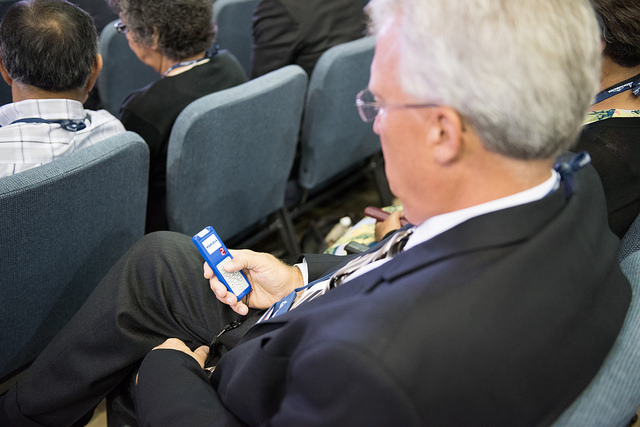“We intend to take one more attempt to test the devices,” President Ted Wilson repeated numerous times during the first week of the General Conference Session in San Antonio. Wilson’s call was aimed to reassure the delegates that it was their intention to include a voting ballot that would not only speed the process of voting but ensure that each vote was an expression of personal decision.
“It is your sacred responsibility to vote according to your conscience and according to how the Holy Spirit has impressed you,” said Wilson. “You should not vote to appease others around you. You vote according to how you are impressed to do so.” What was the last attempt to assess viability of the voting system, failed again. It was declared that for sensitive items, secret ballot will be called for using cards.
The lack of faith in the electronic voting devices used by the delegates has caused a large amount of time to be reassigned to its discussion. During their testing on Thursday, July 2, the electronic devices failed four separate times, causing unrest and distrust among the delegates. Many voiced their opinions in the afternoon session at 4 pm. In response to the negative reception of the devices, the GC decided to revisit the process of voting the next day.
The quest for accuracy
At 6:30 am. on Friday, July 3, the steering committee of the GC Session devoted nearly an hour to the voting devices. According to a source close to the committee, the recurring question asked among those in the meeting was said, How do we restore confidence in the devices’ accuracy and integrity?
Due to the general mistrust, it was decided to test the devices once more. At 9:30 am., Pardon Mwansa, a vice president of the GC and chairperson of that session, announced that they would “try to ascertain if [they] could use the electronic devices for voting.”
Several modifications were made between Thursday and Friday morning’s testing and the technical staff “were confident that the modifications would correct the difficulties from yesterday,” commented Karnik Doukmetzian, general legal counsel for the GC.
As attempted the day before, the delegates who planned to vote all stood and were manually counted. Those same delegates then voted on a signal from the chairperson, using the electronic devices this time. Those two result totals were compared. If the total variance was minimal, the delegates would continue using the electronic voting devices. If not, they would resort to raising cards and manual counting.
The General Conference contracted Meridia Audience Response, an outside company based in Pennsylvania, to provide the electronic voting equipment and devices. MAR personnel are managing the complete voting system during the session. The electronic voting system was initially and effectively implemented at the world church’s Annual Council last October in Silver Spring, Maryland. No problems were experienced at that time.
Digital dilemmas
Some have questioned whether the voting machines were the best course of action due to the frequencies being used. When there are many wireless frequencies, radio frequencies, cell phones and even cordless microphones, it becomes too much and can cause lost connection. To get a more dependable count of votes, it has been suggested to avoid unreliable wireless frequencies and stick with the manual counting. The GC was made aware of this on Thursday, when they shut off the Alamodome’s free Wi-Fi that some suggested may have been overpowering the voting devices. Unfortunately, shutting off the Wi-Fi was not enough and the results of the Friday morning test proved that.
The manual head count totaled 1,701. However, after those same delegates voted using the electronic devices, the total dwindled to only 1,052. Due to the almost 650 vote difference, Mwansa announced that they would be using the green voting cards at this time.
Paper wins
During the Sunday afternoon meetings as the Church Manual was discussed, several delegates voiced their desire to return to the secret ballots due to the sensitive nature of approaching topics. In response, newly re-elected GC president Ted Wilson, took the stage. “We intend to take one more attempt to test the devices,” he announced. “If it is not successful, we will recommend to the body of delegates a motion to cease further attempts to use the electronic system and continue using the green cards and the paper system for secret ballots.”
The testing took place in the same way as on Thursday and Friday. Results were similar and disappointing: the final physical hand count was 1,737 while the electronic voting count was 1,276.
Ultimately the July 5 afternoon session ended with appeasing the delegates: voting devices were dismissed and green cards continued to be used.
Katie Morrison is a communication intern at the Rocky Mountain Conference.
Photo: Enno Mueller










